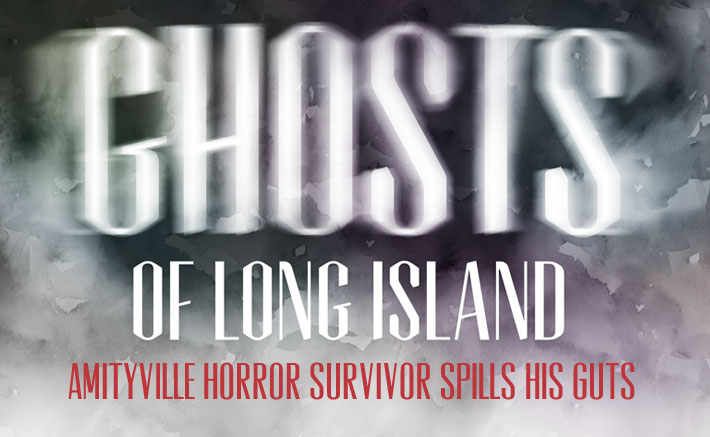
Lutz, now a 43-year-old self-described nondenominational pastor who installs air conditioners in Phoenix for a living, only outlines his version of events—for now.
“What manifested itself in that house was not a result of just the house, it was a result of George’s occult practices,” he says, reiterating prior claims. “And having called those things up, I blame him for what took place there, more so than the house itself. And when we left there, those spirits followed us. And I believe that’s why no one else has had an experience in that house since.”
None of the four homeowners since the Lutz family have claimed anything unusual in the Dutch Colonial, except having to change the address and remove the eerie quarter-round windows to throw off tourists. Likewise, a Press reporter who attended the August 2010 estate sale before the home sold for $950,000 felt nothing amiss in the three-story house, its master bedroom or “weird” basement with the foosball table—just something odd about the fanatics who waited an hour on line for the rare chance to see inside.
The bestselling 1977 book that spawned the franchise included the tag line, “A True Story,” practically daring authors, filmmakers and independent investigators to try to debunk it. Lutz suggests some skeptics have plot holes in their own stories calling it a hoax.
“It’s not a matter of absolutely nothing happened,” he says. “There’s something deeper behind this whole story.”
From where he sits in the front row of the controversy, it’s no mystery. “Why did this story continue to live? There’s a spirit attached to it,” says Lutz, who was 7 years old when he lived in the house. He says his mother answered his lingering questions before she died.
The only certainty is the myriad accusations on either side of the debate—too many to get into here—will continue filling books and movie theaters.
“The story’s never gonna go away, that much is obvious,” Lutz says.
It seems constant attempts to cast the story in a new light only further shrouds the truth. More questions than answers followed the most recent made-for-TV movie, Amityville: The Final Testament, billed as the last prison interview with DeFeo, which aired Halloween 2010 on A&E.
“There’s some kind of entity, I don’t know what it is. It’s torturing me,” DeFeo, now 61, gaunt and his beard gray, said from upstate Green Haven Correctional Facility where he is serving six life sentences. It may well be his final interview, since he believes he will soon die.
DeFeo claims he still is possessed as he says he was when he killed his parents. But he says his sister, Dawn, killed the children—and that she had help from a killer who escaped justice. He admits to killing Dawn.
“I think it could make somebody kill, get killed, kill themselves,” DeFeo, grinning into the camera, said of his supposed possession. “This thing has got power to influence people.”
Among the claims he made when he testified at his trial was that he acted in self defense, was hearing voices and “I didn’t want to kill them, I had no choice. I had to do it,” according to published reports at the time in the Long Island Press when it was a daily paper.
“The biggest things that ever happened were Halloween pranks,” a neighbor shocked at the news told the paper the night of the murders. Nowadays, neighbors dread Oct. 31 for the annual spike in gawkers.
Amityville Historical Society representatives say they have no information about the house—contrary to conspiracy theorists allegations that documentation indicating it was built on an Indian burial ground disappeared. A past president of the group now owns the home.
Otherworldly forces at work or not, the story has taken on a life of its own. But not all the stories that ensued were fiction.
The Amityville case sowed the seeds of suburban fear of Satanism amongst the heavy-metal-listening youth in the years that followed. Related stories periodically continue to surface—and not just the occasional vandals who desecrate houses of worship with demonic graffiti.
Ricky Kasso, aka “The Acid King” of Northport, who reportedly killed 17-year-old Gary Lauwers in 1984 after allegedly telling him to “say you love Satan,” had reportedly performed rituals at the Amityville house. Kasso hanged himself in jail after his arrest.
About two miles away in 1998, a 31-year-old crack-addicted mother claimed her children were demonically possessed when she fatally scalded her 6-year-old daughter and 5-year-old son. She pleaded not guilty by reason of mental defect and remains confined at a state facility for the mentally ill.
And earlier this year in neighboring Massapequa, a 21-year-old self-described Satan-worshipper was shot and killed when police said he lunged at officers with knives in his home. An MTA officer mistakenly shot and killed a Nassau County police officer outside the home moments later.
THE NIGHTMARE CONTINUES
Regardless of whether there was something spooktacular in the Amityville house is besides the larger point Lutz makes. He says the Hollywood depictions of him, his family and the DeFeos on the big screen are “morally, absolutely without excuse.”
Ryan Reynolds as George Lutz hacking a fictionalized version of their dog to death with an axe in the 2005 remake comes to mind. Lutz also takes issue with being depicted as a demonically possessed child. But graphically showing a character based on one of the DeFeo children as a bullet-ridden ghost takes the cake.
“What they’re doing to those kids is disgusting,” Lutz says. But he concedes it’s all an uphill battle.
“It won’t change how I feel about what they’re gonna do to the memory of my mother,” he says. “Or how they’re gonna continue to exploit these children that got brutally murdered. Or exploit the traumatic experiences that I went through as a kid for their gain and profit. That’s why I’m doing what I’m doing now, to set the record straight.”





